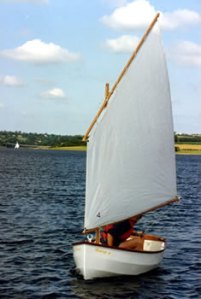Over the last few years I have indulged in a semi-annual winter project of building a dinghy in my basement. Lacking a garage I have been limited to what I can get up the basement stairs and so my builds have been modest in scale. Those who have followed this site have seen my step-by-step adventures with constructing a 7 1/2 foot Greenshank pram as a tender for my Halman 20, Ebony, and an 11 foot Medway skiff for rowing. Both were from plans from Paul Fisher of Selway-Fisher design whose website of boat plans is a delight for dreamers. His boats are both buildable and sailable for those of us with modest skills in both areas.
He has recently posted a new plan for a 9 foot sailing dinghy which I like very much. The plan is actually an old one as he drew it some years ago for a boat-building company which is no longer with us and he has just added the plan to his extensive catalogue.
It is called the Westray 9 and has a 4-plank stitch and glue construction and a very “boaty” shape. At the same width, and about 1 1/2 feet longer than my Greenshank pram, it probably has about the same carrying capacity but with a pointed stem which would make for easier rowing.
What is of more interest to me is the fact that the increased length leaves lots of room for an un-stayed gaff rig mounted in the bow in the catboat style. The plans also give the sail plan for a balanced lug sail. The idea of a “gaffer” is quite appealing as it would give me a few extra strings to pull and is a very traditional rig not usually associated with a boat this small. Paul has also indicated he could supply design for a gunter rig if desired. The design has variations for either a drop centre board (as shown in the sketch) or a dagger board.
The design was produced commercially in fibreglass for a few years in the late 1990s and received a very favourable review in the English yachting magazine Sailing Today. The review gave the sailing dinghy its highest marks 5/5 and noted “she sails well and rows exceptionable well.”
Much as I like rowing, the idea of having a small sail to set when the wind is right is very appealing. There are a number of rivers on the Island blocked from access by sailboats owing to low bridges and the idea of having to row the 15 or so miles up the Hillsborough River is a challenge for me. But to be able to set a sail for the same day-trip has merit. Add to the fact that I can throw it on a trailer and take it to places difficult to access with the Halman 20.
Although unlikely to be built this spring (I would have to dispose of at least one of the boats in the existing fleet first) the Westray 9 is my current dream dinghy. Today, with snow up to the window sills and one dinghy buried beneath the snow and another tucked up a shed dreaming is about all that can be done.
Winter is a dangerous time for sailors and it has become even more so since the internet made it easy to find “things.” It used to be that the greatest danger was the boat show where vendors would prey on the vulnerable water-starved yachtsmen to provide all sorts of “essentials” which would render the upcoming season both easier and more pleasurable. Now the assault on our spirits and wallets is unrelenting. For builders, web sites with boat plans hold the same threat. However there are no drawbacks to dreaming. Even if I never build a Westray I have already spent profitable hours aboard her gazing up as the gentle breeze tugs on the sail and imagining a summer’s day on the West River.






